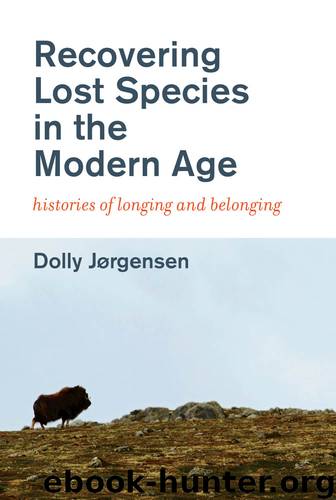Recovering Lost Species in the Modern Age: Histories of Longing and Belonging by Dolly Jorgensen

Author:Dolly Jorgensen
Language: eng
Format: epub
Tags: Animals, Environmental Conservation & Protection, Environmental Science, Nature, Science
Publisher: The MIT Press
Published: 2019-10-29T03:00:00+00:00
Loss and grief for the pigeon were on Leopold’s mind. But his grieving was not for specific dead pigeons, individuals who had been trapped or shot or swatted down with brooms from their perches. These were not who the monument was for. Rather, the monument was for the loss of a species, a wholly intangible yet remarkably tangible thing that could never be replaced, or so Leopold thought.
The Silent Wings dedication text written by Walter E. Scott made it clear that the monument was a dedication to the species, rather than a single individual. The monument should “make us stop our busy life a moment for solemn thought.” Scott urged readers to move through their grief and “lend our efforts in the direction of the perpetuation of our native wildlife in its native habitat.”90 The same sentiment was repeated in other essays in Silent Wings. Hartley H. T. Jackson’s piece “Attitude in Conservation,” for example, derided an editorial published in the San Antonio News in January 1947 for saying that we should not lament the “passing of a non-essential animal”; instead, he argued, the monument to the last Wisconsin passenger pigeon was not only “a token to the dead and the past, but rather as a symbol to the living.”91 The grief, then, should not make us become melancholic and inward-looking, but rather spur on change for the future.
In 1976, the US government issued a pamphlet titled “A Passing in Cincinnati, September 1, 1914” to commemorate the passenger pigeon’s extinction.92 Like Leopold’s text, the pamphlet is set up as a funerary commemoration for Martha, including a graphic style that makes each page look like a gravestone. The text announcing the death of Martha from the Cincinnati Enquirer starts the work, followed by her portrait. After retelling the species extinction story, the text returns to Martha herself and her body as monument. Twice she flew after death—once in 1966, when she was sent to the San Diego Zoological Society’s Golden Jubilee Conservation Conference, and again in 1974, when she appeared in Cincinnati as part of the launch of the Passenger Pigeon Memorial Fund to restore the birdhouse where she (as well as the last Carolina parakeet, who is often forgotten) died.93 The pamphlet is a text written as grieving at a graveside. “A Passing in Cincinnati” assumes that grief for the pigeon will be permanent, just as Martha would be on permanent display.
Martha was not, however, kept on display permanently at the Smithsonian. Her body was put into storage in 1999 when the Birds of the World exhibit was shut down to make room for a new Hall of Mammals.94 She would not appear again in the public eye until 2014, to mark the centenary of her death and the extinction of the passenger pigeon. By the time she made her centenary appearance, talk had already begun about her not being the last.
Download
This site does not store any files on its server. We only index and link to content provided by other sites. Please contact the content providers to delete copyright contents if any and email us, we'll remove relevant links or contents immediately.
How to Do Nothing by Jenny Odell(2640)
A Forest Journey by John Perlin(2583)
The Plant Messiah by Carlos Magdalena(2451)
Babylon's Ark by Lawrence Anthony(2065)
Energy Myths and Realities by Vaclav Smil(2053)
The ESV Study Bible by Crossway Bibles(1885)
Abbey in America by Murray John A(1799)
Fatal Storm by Rob Mundle(1783)
Witness Tree by Lynda V. Mapes(1692)
Shadows on the Gulf by Rowan Jacobsen(1515)
Client Earth by James Thornton(1500)
Brokeback Mountain by Annie Proulx(1467)
Coming Back to Life by Joanna Macy(1461)
Water Rights and the Environment in the United States by John Burch(1411)
Cosmos by Carl Sagan(1396)
Ten Billion by Stephen Emmott(1381)
Mycelium Running: How Mushrooms Can Help Save the World by Paul Stamets(1282)
The overachievers by Robbins Alexandra(1282)
The Uninhabitable Earth by David Wallace-Wells;(1189)
